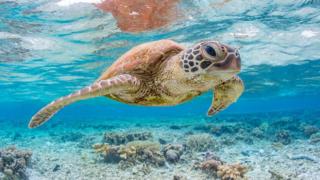 Image copyright Google
Image copyright Google
A new study suggests that ingesting even a single piece of plastic can be deadly for sea turtles.
Researchers found there was a one in five chance of death for a turtle who consumed just one item – rising to 50% for 14 pieces.
The team found that younger turtles are at a higher risk of dying from exposure to plastic than adults.
The authors say their research raises concerns over the long term survival of some turtle species.
The never ending surge of plastic into the world’s oceans is taking an increasing toll on iconic marine species.
 Image copyright BBC Sport
Image copyright BBC Sport
From that information they were able to deduce the role of plastic in causing death – if an animal had ingested more than 200 pieces of plastic, death was inevitable.
Fourteen pieces meant a 50% chance of dying – while one piece gave a 22% chance of mortality.
“Because of their digestive tract, they don’t regurgitate anything,” lead author Dr Britta Denise Hardesty from Australia’s Commonwealth Scientific and Industrial Research Organisation (CSIRO), told BBC News.
“If it ends up in the wrong place, even one little thin, filmy piece of plastic can block that canal and mean that nothing can pass and ultimately the blockage can result in death.”
As well as causing blockages, harder pieces caused internal injuries which often lead to death as well.
The research team also found that younger turtles were taking in far more plastic than adults. Around 23% of juveniles and 54% of post-hatchling turtles had ingested plastic compared to 16% of adults. The scientists say that this greater susceptibility is down to where they live and how they feed.
 Image copyright Kathy Townsend
Image copyright Kathy Townsend
“Young small turtles actually drift and float with the ocean currents as does much of the buoyant, small lightweight plastic,” said Dr Hardesty.
“We think that small turtles are less selective in what they eat than large adults who eat sea grass and crustaceans, the young turtles are out in the oceanic area offshore and the older animals are feeding in closer to shore.”
While sea turtles can live until they are about 80 and reproduce for decades, researchers are concerned for the longer term impact of so many juveniles consuming so much plastic.
“We know that disproportionately finding it more in younger animals who won’t make it to the reproductive state will have long term consequences for the survival of the species,” said Dr Hardesty.
“It’s very concerning.”
Other experts in this field say the new study is an important step towards quantifying the scale of the threat that plastic poses to the lives of sea turtles.
 Image copyright Brazil Photo Press Image caption Turtles face external and internal dangers from plastic – this one was found wrapped in plastic, washed ashore in Brazil
Image copyright Brazil Photo Press Image caption Turtles face external and internal dangers from plastic – this one was found wrapped in plastic, washed ashore in Brazil
“The authors offer a very defensible framework for allowing us to measure the mortality risk resultant from plastic ingestion,” said Prof Brendan Godley, from the University of Exeter, who wasn’t involved with the study.
“It also points to the likelihood that plastic may be a key threat to the smallest life stages. This is of particular concern as pieces of plastics and baby turtles are both likely to be aggregated together in similar areas.”
The authors of the new study want to raise awareness among consumers and political leaders about the threat from plastic and to encourage creative solutions to the issue. One option may well be a plastic tax or deposit scheme.
“Let’s rethink our relationship with plastic,” said Dr Hardesty.
“Let’s put a true cost on plastic so they have a similar value to aluminium cans which we don’t find lost in the environment, they get picked up and they don’t get mismanaged and find their way out into the ocean,” she added.
The study has been published in the journal Scientific Reports.







